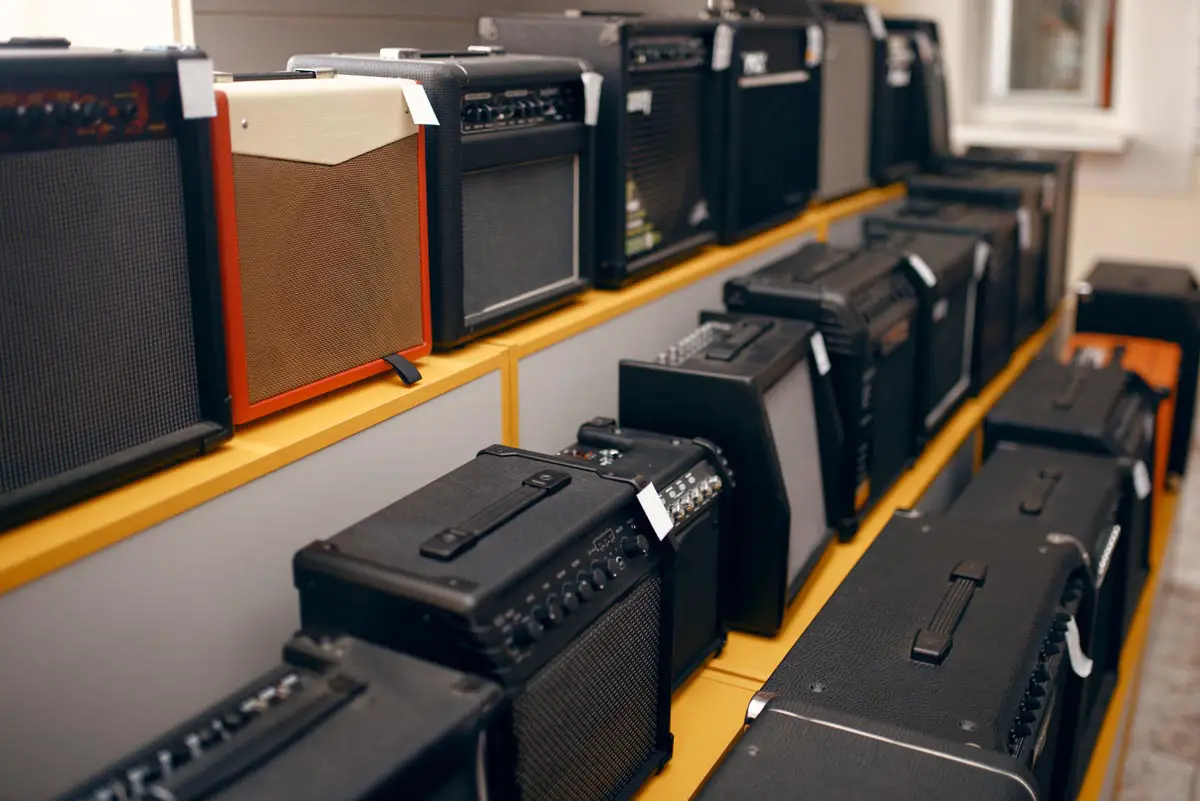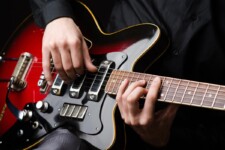Can You Daisy Chain Guitar Amplifiers? Pros/Cons & Hot Tips
So you want your guitar to be even louder! And honestly who hasn’t thought about rocking out with a wall of amps behind them.
Although it may seem like something only the world’s biggest rock bands have the technology to do, there are actually a few ways you can connect multiple amps together at home!
The technique is called daisy chaining and it lets you connect multiple amps together to play the sound from one guitar.
Just don’t blame us when your neighbors start complaining!

Is it Possible To Daisy Chain Guitar Amps?
Yes, it is possible to daisy chain amps however the ability to do so (and the risks involved) depends on the amps you plan to daisy chain together.
The important thing to know is the correct way to connect your amps to avoid damage, while getting the sound you want.
What Is Daisy Chaining and Why Do It?
Daisy chaining (or ‘jumping’ amps) is the act of connecting 2 or more amps together to amplify the sound of one guitar. This idea comes from the need for more volume. Cranking two amps is going to be louder than one amp right?
- By daisy chaining amps together you are able to (in some cases) double your volume or create a stereo loud field when performing live.
. - Another use for daisy chaining could be to chain two less powerful amps together in order to match the volume of your bandmates if they have louder amps.
. - Apart from sheer volume, different amps have different sound characteristics, so daisy chaining two different amps can give you a sound that you couldn’t get from either amp alone.
Can You Destroy Guitar Amps By Daisy Chaining Them?
Chasing more volume does come with its risks. The riskiest way to daisy chain amps is also the easiest way to do it.
If you run your guitar into an amp with SPEAKER OUTS and run these speaker outs into another amp you run the risk of delivering too much power to the second amp.
This can overdrive the amp to the point where you might start to see smoke. So avoid this method at all costs.
There are plenty of other ways to safely daisy chain your amps together, and I’ll show you some easy ways to do this below.
Pros & Cons Of Daisy Chaining Amps
The benefit of daisy chaining guitar amps is that you can get more volume as well as hear your guitar in stereo.
Having extra volume can be great for performing live to let your guitar compete with the volume of the rest of the band.
The ability to play your guitar in stereo is also a huge draw towards daisy chaining amps. This is especially useful if you’re using stereo guitar pedals such as stereo delays.
This will mean that the stereo effects will actually play in stereo creating interesting sonic sounds that you can’t get with a single amp.
The downside of daisy chaining amps is that amps can behave unpredictably when chained together. This can present issues with volume, phasing, and tone.
Phasing is a common issue when daisy chaining guitar amps. Phasing refers to how the sound waves of each amp interact with each other. If two amps are out of phase it means their waveforms are canceling each other out.
Phasing Issues
This can result in the sound coming from the chained amps sounding incomplete. Sometimes you can lose the low end and generally your sound won’t be well rounded like your used to.
Phasing issues can be easily resolved though. If you unplug the guitar cables from one of the amp outputs and reverse the way you plugged it in this will put the two backs in phase.
Amp Tone
Daisy chaining amps can also change the tone of your amps. The amp that you plug your guitar into can sometimes color the tone of the second amplifier that it’s chained to.
This can make the other amp sound similar to the amp your guitar is plugged into, and can be seen as both a positive and negative attribute of daisy chaining.
If your running an amp you love the tone of into another that you’re not as crazy about then this is a great thing. If however, you wanted both amps to deliver their own unique tones then you’re out of luck with certain daisy chain setups.
Are There Better Ways To Connect Two Guitar Amps?
There most certainly are better ways to connect two guitar amps than straight daisy chaining. These methods include using foot pedals and AB/Y splitters.
Using these methods means you can avoid some of the pitfalls of daisy chaining such as overdriving the second amp, by splitting the guitar’s sound instead of duplicating the amp’s sound.
Although that might sound complicated I will explain these different methods below.
3 Ways To Daisy Chain Guitar Amplifiers
Daisy Chain Amp Direct To Amp
Daisy chaining directly from amp to amp is the easiest method to connect two amps together.
To achieve this all you need is the two amps you want to daisy chain, two instrument cables, and a guitar.
If you have an amp with a secondary output on the back or an effects loop, this should be the amp you plug your guitar into. If both amps have these then the order doesn’t matter.
Simply plug your guitar into the first amp as you would normally.
- Then take your second instrument cable and plug that into either the secondary output of your amp or the effects loop output.
- Take the other end of the second cable and plug that into the input of the second amp.
Voilà! you have now daisy chained your amps together.
Daisy Chain Amps Using Foot Pedals
In order to do this, you’ll need a foot pedal that has at least two outputs, (usually a left and right output). You’ll also need three instrument cables and as always a guitar.
Start by plugging your guitar into the foot pedal with one of the instrument cables.
- Then take the other two instrument cables and plug one into each of the outputs on the pedal.
- These instrument cables then get plugged into the two amps you want to daisy chain.
- The guitar signal will travel through the foot pedal and out to both of your amps.
The reason this is so great for stereo effects pedals is that each output relates to a different side of the stereo signal.
For example, if you use a stereo delay these pedals will often create a ping pong effect that jumps from left to right repeatedly. When plugged into a single amp this effect is hard to notice. When connected to two amps this ping pong effect will jump between the amps creating a more dynamic sound.
Daisy Chain Amps using AB/Y Splitters
Using an AB/Y splitter to daisy chain your amps is the most reliable and straightforward option available.
For this method, you will need two amps, three instrument cables, a guitar of course, and an AB/Y splitter.
An AB/Y splitter is a small box that looks like an effects pedal but doesn’t add any effects to your guitar. Instead, you plug your guitar into it and it duplicates your guitar playing across multiple outputs.
To daisy chain your amps with an AB/Y splitter first you need to plug your guitar into the AB/Y splitter’s input.
- Every AB/Y splitter will be a little different but usually, on the back of the pedal, you will find between 2 and 4 outputs.
- Take your other instrument cables and plug them into these outputs.
- Then plug the other ends of these cables into your amps.
Using an AB/Y splitter adds some versatility to your daisy chaining by allowing you to switch amps. You can either choose to duplicate your guitar’s sound across both amps or press it again to switch between sending your guitar’s sound to only one of the amps.
This is useful if you’re jamming and want to see which of your amps best suits the song you are playing.
Is Amp Stacking The Same As Daisy Chaining?
Amp stacking and daisy chaining are two very different things.
Amp stacking is the combination of an amp head connected to one or more guitar cabinets. Amp heads amplify the guitar input but don’t have a speaker. Instead, you connect them to a cabinet that acts as a speaker.
The reason amp stacking is different from daisy chaining is that amp heads are designed to connect to multiple cabinets and these cabinets are amplified equally by the same amp head.
Cabinets are a lot like guitar amps but instead of amplifying the guitar they take the signal from the amp head and make that louder. The main reason this is different from daisy chaining is that when you connect two guitar amps together both amps will amplify the signal individually.
Amp heads are also designed to be hooked up to multiple cabinets and will often have 2 or 3 outputs to achieve just this.




